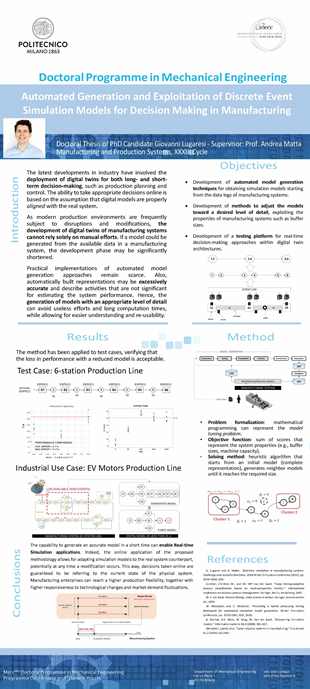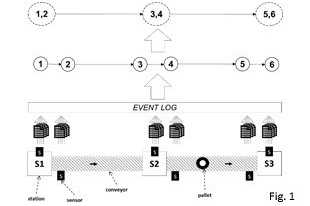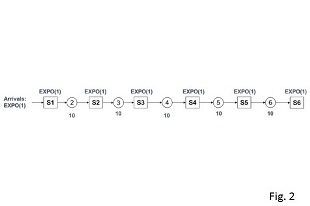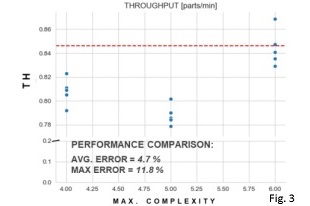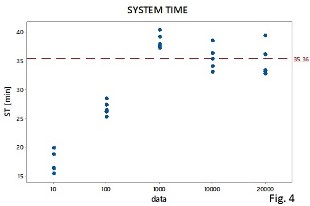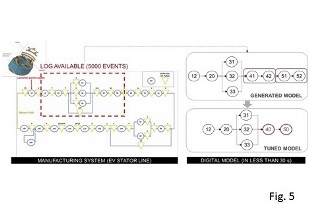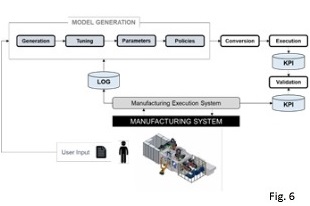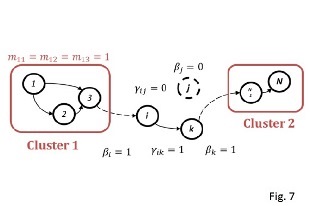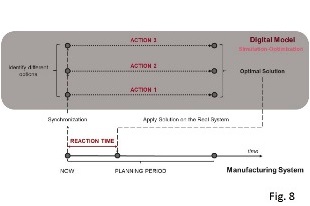
Contacts
Phone: +39.02.2399.8538
Skype: 10342930@polimi.it
E-mail: giovanni.lugaresi@polimi.it
Engineering Design and Manufacturing for the Industry of the Future
Supervisor: Prof. Andrea Matta
Tutor: Prof. Giorgio Colombo
University of Origin: Politecnico di Milano - Mechanical Engineering
Thesis Title: Automated Generation and Exploitation of Discrete Event Simulation Models for Decision Making in Manufacturing
Introduction
The latest developments in industry have involved the deployment of digital twins for both long- and short-term decision-making, such as production planning and control. The ability to take appropriate decisions online is based on the assumption that digital models are properly aligned with the real system.
As modern production environments are frequently subject to disruptions and modifications, the development of digital twins of manufacturing systems cannot rely solely on manual efforts. If a model could be generated from the available data in a manufacturing system, the development phase may be significantly shortened.
Practical implementations of automated model generation approaches remain scarce. Also, automatically built representations may be excessively accurate and describe activities that are not significant for estimating the system performance. Hence, the generation of models with an appropriate level of detail can avoid useless efforts and long computation times, while allowing for easier understanding and re-usability.
Objectives
- Development of automated model generation techniques for obtaining simulation models starting from the data logs of manufacturing systems.
- Development of methods to adjust the models toward a desired level of detail, exploiting the properties of manufacturing systems such as buffer sizes.
- Development of a testing platform for real-time decision-making approaches within digital twin architectures.
Results
The method has been applied to test cases, verifying that the loss in performance with a reduced model is acceptable.
Test Case: 6-station Production Line (Fig.2, Fig.3, Fig.4)
Industrial Use Case: EV Motors Production Line (Fig.5)
Method
- Problem formalization: mathematical programming can represent the model tuning problem.
- Objective function: sum of scores that represent the system properties (e.g., buffer sizes, machine capacity).
- Solving method: heuristic algorithm that starts from an initial model (complete representation), generates neighbor models until it reaches the required size.
Conclusions
The capability to generate an accurate model in a short time can enable Real-time Simulation applications. Indeed, the online application of the proposed methodology allows for adapting simulation models to the real system counterpart, potentially at any time a modification occurs. This way, decisions taken online are guaranteed to be referring to the current state of the physical system. Manufacturing enterprises can reach a higher production flexibility, together with higher responsiveness to technological changes and market demand fluctuations.
References
G. Lugaresi, A. Matta, Real-time simulation in manufacturing systems: Challenges and research directions, 2018 Winter Simulation Conference (WSC), pp. 3319–3330, IEEE, 2018
C.W. Günther, W.M.P. Van Der Aalst, Fuzzy mining–adaptive process simplification based on multi-perspective metrics, International conference on business process management, Springer, Berlin, Heidelberg, 2007.
W.M.P. Van Der Aalst, Process Mining - Data Science in Action, Springer, second edition ed., 2016.
M. Mesabbah, S. McKeever, Presenting a hybrid processing mining framework for automated simulation model generation, Winter Simulation Conference, pp. 1370–1381, IEEE, 2018.
A. Rozinat, R.S. Mans, M. Song, W.M.P. Van Der Aalst, Discovering simulation models, Information systems 34.3, pp 305-327, 2009
L. Monostori et al., Cyber-physical systems in manufacturing, Cirp Annals 65.2: 621-641, 2016

